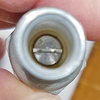Reading the issues, dealing with funny running engines, did some more searching and LO AND BEHOLD... search for the Champion industrial spark plug catalog from 2012, on page four they describe the issue, and explain they only use fired in resistors for longer life. The chart is resistance vs temperature, something no one may be considering. apparently the resistance is changing a lot with temp, IE once airborne and up to cruising conditions these plugs are not the same as on the ramp, or in a test fixture. They knew all about it before 2012.
dickc
dickc

